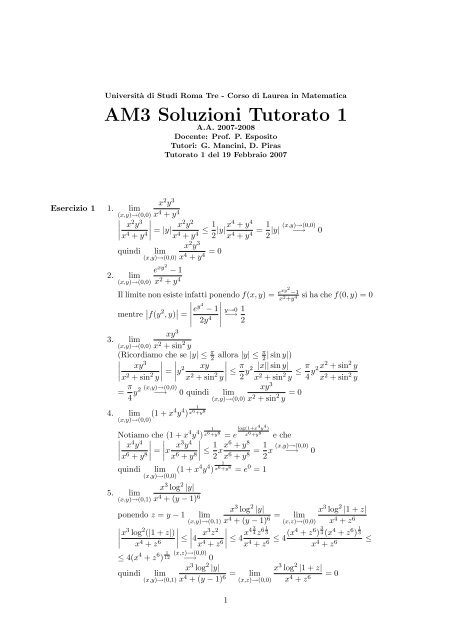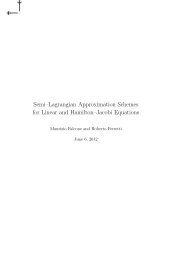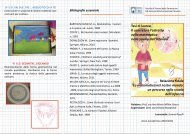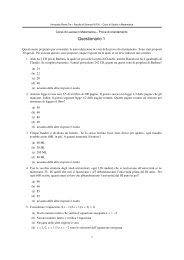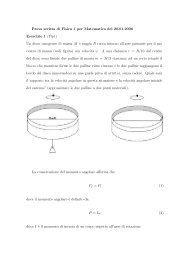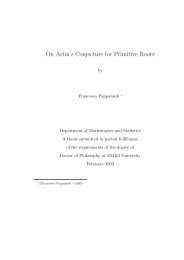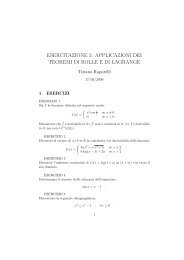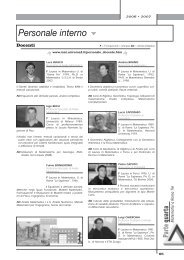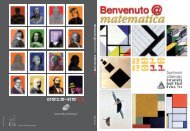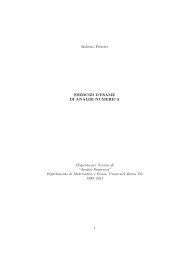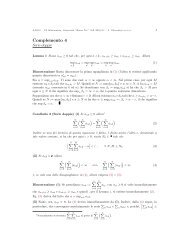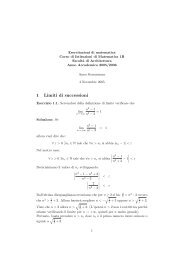AM3 Soluzioni Tutorato 1 - Dipartimento di Matematica
AM3 Soluzioni Tutorato 1 - Dipartimento di Matematica
AM3 Soluzioni Tutorato 1 - Dipartimento di Matematica
You also want an ePaper? Increase the reach of your titles
YUMPU automatically turns print PDFs into web optimized ePapers that Google loves.
Università <strong>di</strong> Stu<strong>di</strong> Roma Tre - Corso <strong>di</strong> Laurea in <strong>Matematica</strong><strong>AM3</strong> <strong>Soluzioni</strong> <strong>Tutorato</strong> 1A.A. 2007-2008Docente: Prof. P. EspositoTutori: G. Mancini, D. Piras<strong>Tutorato</strong> 1 del 19 Febbraio 2007x 2 y 3Esercizio 1 1. lim(x,y)→(0,0)x 4 + y 4x 2 y 3 ∣ ∣∣∣ x 2 y 2∣x 4 + y 4 = |y|x 4 + y 4 ≤ 1 + y 42 |y|x4 x 4 + y 4 = 1 (x,y)→(0,0)|y| −→ 02x 2 y 3quin<strong>di</strong> lim(x,y)→(0,0) x 4 + y 4 = 0e xy2 − 12. lim(x,y)→(0,0) x 2 + y 4Il limite non esiste infatti ponendo f(x, y) = exy2 −1si ha che f(0, y) = 0x 2 +y 4mentre ∣ ∣f(y 2 , y) ∣ ∣ e y4 − 1 ∣∣∣∣y→0=∣ 2y 4 −→ 1 2xy 33. lim(x,y)→(0,0) x 2 + sin 2 y(Ricor<strong>di</strong>amo che se |y| ≤ π 2 allora |y| ≤ π 2 | siny|)xy 3∣ ∣∣∣ ∣x 2 + sin 2 y∣ = y 2 xyx 2 + sin 2 y∣ ≤ π |x||siny|y22 x 2 + sin 2 y ≤ π + sin 2 y4 y2x2 x 2 + sin 2 y= π (x,y)→(0,0)y2 −→ 0 quin<strong>di</strong> lim4 (x,y)→(0,0)4. lim (1 +(x,y)→(0,0) x4 y 4 )1x 6 +y 8xy 3x 2 + sin 2 y = 0Notiamo che (1 + x 4 y 4 1) x 6 +y 8 = e log(1+x4 y 4 )x 6 +y 8 e chex 4 y 4 ∣ ∣∣∣ ∣x 6 + y 8 =∣ x x3 y 4 ∣ ∣∣∣x 6 + y 8 ≤ 1 + y 82 xx6 x 6 + y 8 = 1 2 x (x,y)→(0,0)−→ 0quin<strong>di</strong> lim (1 +(x,y)→(0,0) x4 y 4 ) x 6 +y 8 = e 0 = 11x 3 log 2 |y|5. lim(x,y)→(0,1) x 4 + (y − 1) 6x 3 log 2 |y|ponendo z = y − 1 lim(x,y)→(0,1) x 4 + (y − 1) 6 = lim x 3 log 2 |1 + z|(x,z)→(0,0) x 4 + z 6x 3 log 2 ∣ (|1 + z|) ∣∣∣ ∣ x 4 + z 6 ≤∣ 4 x3 z 2 ∣ ∣∣∣ 4zx 4 + z 6 ≤ 4 x43 61 3x 4 + z 6 ≤ + z 6 ) 3 4(x 4 + z 6 ) 1 34(x4 x 4 + z 6 ≤≤ 4(x 4 + z 6 ) 1 (x,z)→(0,0)12 −→ 0quin<strong>di</strong>lim(x,y)→(0,1)x 3 log 2 |y|x 4 + (y − 1) 6 =1lim x 3 log 2 |1 + z|(x,z)→(0,0) x 4 + z 6 = 0
x 2 + y 26. lim(x,y)→(0,0) x 2 + sin 2 yx 2 + y 2 ∣ ∣∣∣∣x 2 + sin 2 y − 1 =∣≤ π2 (x,y)→(0,0)y2 −→ 04quin<strong>di</strong>lim(x,y)→(0,0)y 2 − sin 2 ∣y ∣∣∣x 2 + y 2 ≤x 2 + y 2x 2 + sin 2 y = 1y 4x 2 + sin 2 y ≤ π24 y2 sin 2 yx 2 + sin 2 y ≤Esercizio 2 1.2.3.4.5.∫ π20∫ π20= 3sin 2 xdx =sin 4 xdx =∫ π20= 3 4 π − 3 ∫ π2∫ +∞0= 1 2∫ π20∫ π201 − cos2x2= π 4 − [ 14 sin 2x ] π20= π 4sin 3 xsinxdx = − [ sin 3 xcos x ] π 20+ 3sin 2 x(1 − sin 2 x)dx = 30sin 4 xdx =⇒ 41(x 2 + 2) 2dx = 1 21x 2 + 2 dx − 1 2∫ ∞∫0+∞0+ 1 2∫ 0 +∞0∫ +∞= 1 4 0√2=16 π∫ 120∫ 120∫ ∞x 2(x 2 + 2) 2dx = 1 21x 2 + 2 = 1 21(x 2 + 2) 2dx = 1 21x 2 + 2 dx = 1 8∫ +∞∫ 0 +∞∫0+∞∫0+∞0∫ ∞∫0∞0∫ π20∫ π20sin 2 xdx − 3∫ π2sin 4 xdx = 3 4 π =⇒ ∫ π22(x 2 + 2) 2dx = 1 2x 2(x 2 + 2) 2dx Max ddx (− 1∫ ∞00∫ π20sin 4 xdx =0sin 2 xcos 2 xdxsin 4 xdx = 3 16 π2 + x 2 − x 2(x 2 + 2) 2 dx =x 2 + 2 )dx = 1 [−x2 x 2 + 201x 2 + 2 quin<strong>di</strong>1x 2 + 2 dx − 1 ∫ +∞x 22 0 (x 2 + 2) 2dx =√ ∫1 2 ∞( √ x 2) 2 + 1 dx = 18 y 2 + 1 dy =0] +∞x 3∫ 1x 4 − 2x 3 + 2x 2 − 2x + 1 dx = 2 x 30 (x 2 + 1)(x − 1) 2dx =1x − 1 + 1 12 (x − 1) 2 + 1 1[log(|x2 x 2 + 1 dx = − 1|) − 1 12 x − 1 ++ 1 2 arctanx ]12∫ 10= log 1 2 + 1 2 + arctan 1 2arctanxcosh xdx = 0 perchè è l’integrale <strong>di</strong> una funzione <strong>di</strong>spari−1 1 + x2 su un intervallo simmetrico rispetto all’origine+2
Esercizio 31. A è l’insieme che si ottiene intersecando il cerchio unitario con leparabole y = x 2 e y = −x 210.5-0.75 -0.5 -0.25 0.25 0.5 0.75-0.5-12. B è l’insieme che si ottiene intersecando il cerchio <strong>di</strong> centro (0, 1) eraggio 1 con la regione del semipiano superiore compresa tra le rettey = −x ed y = x21.510.5-1 -0.5 0.5 13. C è l’insieme che si ottiene intersecando la regione del semipiano x > 0compresa tra i grafici delle funzioni y = arctanx e y = − arctanx conla regione <strong>di</strong> piano delimitata superiormente dalla retta y = 1 − x0.40.2-0.20.5 1 1.5 2-0.4-0.6-0.8-14. D il settore della corona centrata nell’ origine <strong>di</strong> raggii 1 e 2 compresatra l’asse delle x e la retta y = x3
1.41.210.80.60.40.20.25 0.5 0.75 1 1.25 1.5 1.75 22Esercizio 4 1. A è una sfera con centro nel punto (2, 0, 0) e raggio 2012-1-2210-1-2012342. B è la parte interna del cono z 2 = x 2 + y 2 delimitata dai piani z = 1 ez = −110.50-0.5-1-1-0.500.511-1-0.500.54
3. C è la porzione del paraboloide z = 1 − x 2 − y 2 ( che è un paraboloide<strong>di</strong> vertice (0, 0, 1) con asse parallelo all’asse z e concavità verso il basso)contenuta nel semispazio z > 010.750.50.250-1-0.500.5110.50-0.5-14. D è il solido <strong>di</strong> rotazione che si ottiene ruotando il sottografico dellafunzione z = cosh y nel piano x = 0 attorno all’asse z0-2 21020-1-25. E è l’insieme ottenuto tagliando l’ellissoide con semiassi <strong>di</strong> lunghezza2,2 e 1 con il piano y = z2110-2-10.50-0.5-2-105


